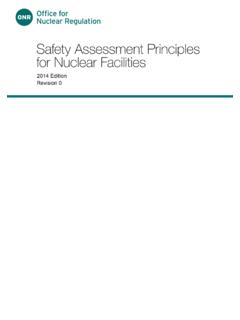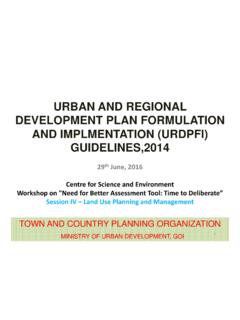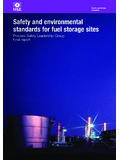Transcription of NDA Strategy 2021 - GOV.UK
1 Strategy Effective from March 2021 Cleaning up the UK s earliest nuclear sites, caring for people and the environmentNuclearDecommissioning AuthorityNuclear Decommissioning Authority StrategyEffective from March 2021 Strategy presented to Parliament pursuant to Schedule 2 of the Energy Act 2004. Strategy presented to Scottish Parliament pursuant to Schedule 2 of the Energy Act 2004. March 2021SG/2021/48 NDA Strategy3 Some images supplied courtesy of site licence effort is taken to ensure the accuracy of material or images produced or used by the , the NDA cannot guarantee that the images shown will always be current, accurate or complete and does not warrant or endorse the accuracy or completeness of the images.
2 nuclear Decommissioning Authority (2021) nuclear Decommissioning Authority copyright (2021)This publication is licensed under the terms of the Open Government Licence except where otherwise stated. To view this licence, visit Where we have identified any third party copyright information you will need to obtain permission from the copyright holders concerned. This publication is available at Any enquiries related to this publication should be sent to us at: NDA Strategy Herdus House Westlakes Science & Technology Park Moor Row Cumbria CA24 3HU ISBN 978-1-5286-2451-0 CCS0321136060 03/21 Printed on paper containing 75% recycled fibre content minimumPrinted in the UK by the APS Group on behalf of the Controller of Her Majesty s Stationery Office4 ContentsPreface introduction Background Current Context Funding Our Approach to Strategy Strategic Themes and Topics Strategy Management Lessons from Strategy (2016)
3 Our Evolving Strategy Site Decommissioning and Remediation 26 Case Study: Ponds and Silos at Sellafield 31 Decommissioning 32 Case Study: Timing of the Magnox Reactor Decommissioning Strategy 35 Land Quality Management 37 Site Interim and End States 39 Case Study: Optimising Site End States 42 Land Use Spent Fuels Spent Oxide Fuel Spent Magnox Fuel 52 Spent Exotic Fuel 54 The Vision: nuclear Safeguards 56 nuclear Materials Plutonium Uranium 63 Case Study: Export of High Enriched Uranium in Support of Medical Isotope Production Integrated Waste Management Radioactive Waste 72 Case Study: Thermal Treatment 79 Case Study: Packaging 79 The Vision.
4 The Disposal Capacity Needed to Complete the Mission 80 Liquid and Gaseous Discharges Non-Radioactive Waste 84 Critical Enablers Health, Safety, Environment and Wellbeing 89 Case Study: Mental Health and Wellbeing 92 Sustainability Security and Resilience Cyber Security 98 Case Study: Exercise Purple Lumi 100 Research, Development and Innovation 101 Case Study: Innovation 104 The Vision: Encouraging Innovation 105 People 106 Case Study: Nucleargraduates Asset Management 111 Case Study: Quality and Continuous Improvement (First Generation Magnox Storage Pond) 112 Supply Chain 114 Case Study: Supply Chain Small and Medium Enterprise Engagement 116 Information Governance 117 Case Study: Higher Activity Waste Package Records 119 Socio-Economics 120 Case Study.
5 Scrabster Harbour (Caithness) 123 Public and Stakeholder Engagement 124 Transport and Logistics 127 Case Study: Consolidation of Spent Fuel and nuclear Materials 130 International Relations 131 Case Study: Developing Relationships in Japan 133 Non-NDA Liabilities 134 Case Study: Treatment and Storage of Atomic Weapons Establishment Higher Activity Waste 136 Information on the NDA group 138 References 159 Appendices 162A Summary of the Integrated Impact Assessment 162B Summary of Expected Expenditure and Income 164 Glossary 165 Abbreviations 168 Key Glossary terms
6 Appear in italics(SOxx) refer to the Strategic Outcomes as reported in the Mission Progress Report NDA Strategy51,046 hectares of designated land on nuclear licensed sites17 nuclear sites across the UK15,000 employees across the estate800+ buildings to be demolishedOur Estate6 PrefaceIn 2005, the nuclear Decommissioning Authority (NDA) was established as a Non-Departmental Public Body under the Energy Act (2004) (ref 1).Our purpose is to clean up the UK s earliest nuclear sites safely, securely and cost effectively.
7 Doing this with care for our people, communities and the environment is at the heart of our work. Our Strategy is founded on our commitment to overcoming the challenges of nuclear clean-up and decommissioning, leaving our sites safe and ready for their next use. We work with UK government and the devolved administrations to ensure their policies are reflected in our Strategy and implemented at our sites. Our sponsoring department is the Department for Business and Industrial Strategy (BEIS), with additional obligations to Scottish ministers for matters affecting Scotland.
8 Our clean-up mission covers 17 sites, 14 in England and Wales as designated by the Secretary of State for BEIS and 3 in Scotland also designated jointly by the Scottish ministers. We have a range of supplementary functions including supply chain development, research and development, skills, socio-economic support for local communities, and stakeholder engagement. We are also responsible for implementing both geological disposal and the UK nuclear industry s Solid Low Level Waste Strategy (ref 2) and we perform certain advisory functions for the Secretary of State.
9 The Energy Act (2004) (ref 1) requires us to review and publish our Strategy every 5 years but we continually develop our Strategy to reflect our latest understanding enabling us to make progress in the most appropriate way. This Strategy , our fourth iteration, continues that evolution and improvement and since the publication of our last Strategy in 2016 (ref 3), we have advanced our thinking in some important areas including site decommissioning and remediation and integrated waste management. In this Strategy , we present the challenges, our proposed direction over the next Strategy period and the actions we are planning to progress our mission.
10 Implementation of this Strategy is dependent upon continual assessment of affordability and value for money as well as business case approvals at the time of implementation. Delivery of the Strategy will benefit from a simpler NDA group operating model, founded on alignment and collaboration, and focus on value for money. We recognise that, in the short to medium-term, the COVID-19 pandemic will put significant pressure on public sector finances which may impact on our future funding settlements and consequentially mean we need to review our strategic and delivery responsibility is important to us and is fundamental to our Strategy .














